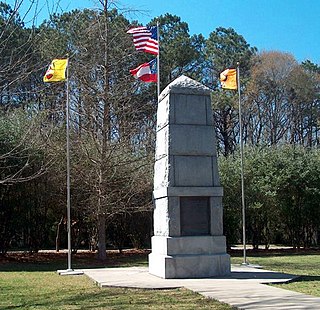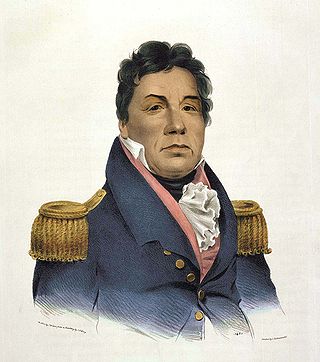Related Research Articles

The Choctaw are a Native American people originally based in the Southeastern Woodlands, in what is now Alabama and Mississippi. Their Choctaw language is a Western Muskogean language. Today, Choctaw people are enrolled in three federally recognized tribes: the Choctaw Nation of Oklahoma, Mississippi Band of Choctaw Indians, and Jena Band of Choctaw Indians in Louisiana.

Indian Territory and the Indian Territories are terms that generally described an evolving land area set aside by the United States government for the relocation of Native Americans who held original Indian title to their land as a sovereign independent state. The concept of an Indian territory was an outcome of the U.S. federal government's 18th- and 19th-century policy of Indian removal. After the American Civil War (1861–1865), the policy of the U.S. government was one of assimilation.

The Trail of Tears was an ethnic cleansing and forced displacement of approximately 60,000 people of the "Five Civilized Tribes" between 1830 and 1850 by the United States government. As part of the Indian removal, members of the Cherokee, Muscogee (Creek), Seminole, Chickasaw, and Choctaw nations were forcibly removed from their ancestral homelands in the Southeastern United States to newly designated Indian Territory west of the Mississippi River after the passage of the Indian Removal Act in 1830. The Cherokee removal in 1838 was brought on by the discovery of gold near Dahlonega, Georgia, in 1828, resulting in the Georgia Gold Rush.

The Chickasaw are an Indigenous people of the Southeastern Woodlands, United States. Their traditional territory was in northern Mississippi, northwestern and northern Alabama, western Tennessee and southwestern Kentucky. Their language is classified as a member of the Muskogean language family. In the present day, they are organized as the federally recognized Chickasaw Nation.

Scott County is a county located in the central part of the U.S. state of Kentucky. As of the 2020 census, the population was 57,155. Scott County is part of the Lexington–Fayette, Kentucky Metropolitan Statistical Area. Its county seat and largest city is Georgetown.

The term Five Civilized Tribes was applied by European Americans in the colonial and early federal period in the history of the United States to the five major Native American nations in the Southeast, the Cherokee, Chickasaw, Choctaw, Muscogee, and Seminoles. Americans of European descent classified them as "civilized" because they had adopted attributes of the Anglo-American culture.

Robert Ward Johnson was an American planter and lawyer who served as the senior Confederate States senator for Arkansas, a seat that he was elected to in 1861. He previously served as a delegate from Arkansas to the Provisional Congress of the Confederate States from 1861 to 1862.

The Choctaw Nation of Oklahoma is a Native American territory covering about 6,952,960 acres, occupying portions of southeastern Oklahoma in the United States. The Choctaw Nation is the third-largest federally recognized tribe in the United States and the second-largest Indian reservation in area after the Navajo. As of 2011, the tribe has 223,279 enrolled members, of whom 84,670 live within the state of Oklahoma and 41,616 live within the Choctaw Nation's jurisdiction. A total of 233,126 people live within these boundaries, with its tribal jurisdictional area comprising 10.5 counties in the state, with the seat of government being located in Durant, Oklahoma. It shares borders with the reservations of the Chickasaw, Muscogee, and Cherokee, as well as the U.S. states of Texas and Arkansas. By area, the Choctaw Nation is larger than eight U.S. states.

Pushmataha, the "Indian General", was one of the three regional chiefs of the major divisions of the Choctaw in the 19th century. Many historians considered him the "greatest of all Choctaw chiefs". Pushmataha was highly regarded among Native Americans, Europeans, and white Americans, for his skill and cunning in both war and diplomacy.
The Mississippi Band of Choctaw Indians is one of three federally recognized tribes of Choctaw people, and the only one in the state of Mississippi. On April 20, 1945, this tribe organized under the Indian Reorganization Act of 1934. Their reservation included lands in Neshoba, Leake, Newton, Scott, Jones, Attala, Kemper, and Winston counties. The Mississippi Choctaw regained stewardship of their mother mound, Nanih Waiya mounds and cave in 2008. The Mississippi Band of Choctaw have declared August 18 as a tribal holiday to celebrate their regaining control of the sacred site. The other two Choctaw groups are the Choctaw Nation of Oklahoma, the third largest tribe in the United States, and the Jena Band of Choctaw Indians, located in Louisiana.

The Chickasaw Nation is a federally recognized Native American tribe with headquarters in Ada, Oklahoma, in the United States. They are an Indigenous people of the Southeastern Woodlands, originally from northern Mississippi, northwestern Alabama, southwestern Kentucky, and western Tennessee. Today, the Chickasaw Nation is the 13th largest tribe in the United States.

The history of Oklahoma refers to the history of the state of Oklahoma and the land that the state now occupies. Areas of Oklahoma east of its panhandle were acquired in the Louisiana Purchase of 1803, while the Panhandle was not acquired until the U.S. land acquisitions following the Mexican–American War (1846–1848).

Peter Perkins Pitchlynn was a Choctaw chief of mixed Native and European heritage. He was principal chief of the Choctaw Republic from 1864-1866 and surrendered to the Union on behalf of the nation at the end of the Civil War.

The Choctaw freedmen are former enslaved African Americans who were emancipated and granted citizenship in the Choctaw Nation after the Civil War, according to the tribe's new peace treaty with the United States. The term also applies to their contemporary descendants.

Robert McDonald Jones was a Choctaw senator and prominent Confederate politician. He was born in Mississippi and later relocated to Indian Territory. He was educated at the Choctaw Academy in Blue Springs, Kentucky, where he received a diploma signed by future Vice President Richard Mentor Johnson. During the removal of Choctaws to Indian Territory, he accepted a contract and worked as translator for the United States to the tribe. He also led a removal party that included a large party of livestock. After removal, Jones opened several trading posts along the Red River. In addition to stores, Jones ran several large plantations, growing cotton and several other crops. In 1849, Jones exported 700 bales of cotton, which he shipped to New Orleans in one of his two Steamships. Jones built two sprawling mansions on his plantations Lake West and Rose Hill, complete with luxurious furnishings from around the world. According to the 1860 census, Jones owned over 230 slaves, though some have argued that he owned as many as 500.
The following outline is provided as an overview of and topical guide to United States federal Indian law and policy:
On the eve of the American Civil War in 1861, a significant number of Indigenous peoples of the Americas had been relocated from the Southeastern United States to Indian Territory, west of the Mississippi. The inhabitants of the eastern part of the Indian Territory, the Five Civilized Tribes, were suzerain nations with established tribal governments, well established cultures, and legal systems that allowed for slavery. Before European Contact these tribes were generally matriarchial societies, with agriculture being the primary economic pursuit. The bulk of the tribes lived in towns with planned streets, residential and public areas. The people were ruled by complex hereditary chiefdoms of varying size and complexity with high levels of military organization.
James Lawrence McDonald (c. 1801 — September 1831), was a member of the American Indian tribe called the Choctaw and the first Native leader of his generation to be trained in the American legal system. Thus, he is known as the first Native American lawyer. He was also the first Native activist to make the case for Indian rights directly to American political leaders and to negotiate for those rights in a formal agreement. McDonald did not believe in the use of force in resisting American westward expansion. Instead, he believed that political negotiations between Native American leaders and the United States would be more effective in the fight against the displacement of Natives and would allow for the long-term survival of Native American communities. McDonald urged the U.S. Congress to protect the rights of Native Americans and delayed the removal of his tribe from ancestral lands. As an advisor to Choctaw chiefs and eventual lawyer of the tribe, McDonald successfully negotiated peace treaties with the United States federal government. These negotiations allowed fair compensation for previously ceded land that was undervalued in earlier agreements. He also promoted programs of Indian education and wrote on behalf of the elected tribal governments. McDonald’s work as a lawyer and political activist paved a new path in which future Native American leaders were able to defend the rights of their territory using the American legal system. His career marked the birth of a new approach to federal power, and by extension, the beginning of political activism that was to inspire tribal leaders across the continent.
Cyrus Kingsbury was a Christian missionary active among the American Indians in the nineteenth century. He first worked with the Cherokee and founded Brainerd Mission near Chickamauga, Tennessee, later he served the Choctaw of Mississippi. He was known as "the Father of the Missions" in Indian Territory.
The History of the Choctaws, or Chahtas, are a Native American people originally from the Southeast of what is currently known as the United States. They are known for their rapid post-colonial adoption of a written language, transitioning to yeoman farming methods, and having European-American and African-Americans lifestyles enforced in their society.
References
- ↑ Tim Talbott, “Choctaw Indian Academy,” ExploreKYHistory, accessed February 28, 2021, https://explorekyhistory.ky.gov/items/show/594.
- ↑ Not Just a Hunting Ground: Native Americans in Kentucky - Choctaw Academy.” Lex History, Lexington History Museum, lexhistory.org/edu/not-just-hunting-ground-native-americans-kentucky-choctaw-academy. Exhibit Panel http://lexhistory.org/sites/default/files/Choctaw%20academy.pdf
- ↑ Katherine Flynn, "Kentucky Ophthalmologist Fundraises to Save Choctaw Academy", Preservation Magazine, https://savingplaces.org/stories/kentucky-opthalmologist-fundraises-choctaw-academy#.Yg0ehurMJPY